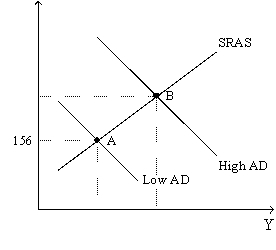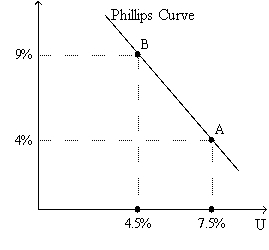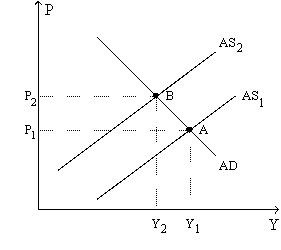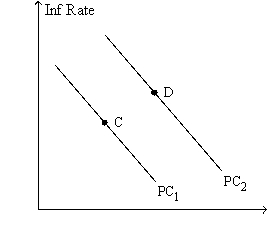A) from 1861-1957 for the United Kingdom.
B) from 1861-1957 for the United States.
C) mostly from the post-World War II period in the United Kingdom.
D) mostly from the post-World War II period in the United States.
F) B) and C)
Correct Answer

verified
Correct Answer
verified
Multiple Choice
In response to the financial crisis of 2007-2008,policymakers used
A) expansionary monetary policy and expansionary fiscal policy.
B) expansionary monetary policy and contractionary fiscal policy.
C) contractionary monetary policy and expansionary fiscal policy.
D) contractionary monetary policy and contractionary fiscal policy.
F) A) and C)
Correct Answer

verified
Correct Answer
verified
Multiple Choice
If the central bank increases the money supply,in the short run,the price level
A) and unemployment rise.
B) rises and unemployment falls.
C) falls and unemployment rises.
D) and unemployment fall.
F) C) and D)
Correct Answer

verified
Correct Answer
verified
True/False
A given short-run Phillips curve shows that an increase in the inflation rate will be accompanied by a lower unemployment rate in the short run.
B) False
Correct Answer

verified
Correct Answer
verified
Multiple Choice
In the long run,inflation
A) and unemployment are primarily determined by labor market factors.
B) and unemployment are primarily determined by the rate of money supply growth.
C) is primarily determined by the rate of money supply growth while unemployment is primarily determined by labor market factors.
D) is primarily determined by labor market factors while unemployment is primarily determined by the rate of money supply growth.
F) A) and C)
Correct Answer

verified
Correct Answer
verified
True/False
An adverse supply shock shifts the short-run Phillips curve to the left.
B) False
Correct Answer

verified
Correct Answer
verified
Multiple Choice
According to the Phillips curve,unemployment and inflation are negatively related in
A) the short run and in the long run.
B) the short run,but not in the long run.
C) the long run,but not in the short run.
D) neither the long run nor the short run.
F) B) and C)
Correct Answer

verified
Correct Answer
verified
Multiple Choice
Figure 22-3.The left-hand graph shows a short-run aggregate-supply (SRAS) curve and two aggregate-demand (AD) curves.On the left-hand diagram,Y represents output and on the right-hand diagram,U represents the unemployment rate. 
 -Refer to Figure 22-3.What is measured along the vertical axis of the left-hand graph?
-Refer to Figure 22-3.What is measured along the vertical axis of the left-hand graph?
A) the wage rate
B) the inflation rate
C) the price level
D) the change in output from one year to the next
F) B) and D)
Correct Answer

verified
Correct Answer
verified
Multiple Choice
The position of the long-run Phillips curve depends on
A) the inflation rate and the natural rate of unemployment.
B) the inflation rate but not the natural rate of unemployment.
C) the natural rate of unemployment,but not the inflation rate.
D) neither the natural rate of unemployment nor the inflation rate.
F) B) and D)
Correct Answer

verified
Correct Answer
verified
Multiple Choice
A movement to the left along a given short-run Phillips curve could be caused by
A) a reduction in the natural rate of unemployment or expansionary monetary policy.
B) expansionary monetary policy,but not a reduction in the natural rate of unemployment.
C) either a reduction in the natural rate of unemployment or a contractionary monetary policy.
D) contractionary monetary policy,but not a reduction in the natural rate of unemployment.
F) None of the above
Correct Answer

verified
Correct Answer
verified
Multiple Choice
If unemployment is above its natural rate,what happens to move the economy to long-run equilibrium?
A) Inflation expectations rise which shifts the short-run Phillips curve to the right.
B) Inflation expectations rise which shifts the short-run Phillips curve to the left.
C) Inflation expectations fall which shifts the short-run Phillips curve to the right.
D) Inflation expectations fall which shifts the short-run Phillips curve to the left.
F) A) and C)
Correct Answer

verified
Correct Answer
verified
Multiple Choice
Figure 22-8.The left-hand graph shows a short-run aggregate-supply (SRAS) curve and two aggregate-demand (AD) curves.On the right-hand diagram,"Inf Rate" means "Inflation Rate." 
 -Refer to Figure 22-8.Which of the following events could explain the shift of the aggregate-supply curve from AS1 to AS2?
-Refer to Figure 22-8.Which of the following events could explain the shift of the aggregate-supply curve from AS1 to AS2?
A) a reduction in firms' costs of production
B) a reduction in taxes on consumers
C) an increase in the price level
D) an increase in the world price of oil
F) A) and C)
Correct Answer

verified
Correct Answer
verified
Multiple Choice
From 1993-2001 the U.S.economy experienced
A) relatively low inflation and unemployment rates.
B) relatively high inflation and unemployment rates.
C) relatively low inflation rates and relatively high unemployment rates.
D) relatively high inflation rates and relatively low unemployment rates.
F) A) and B)
Correct Answer

verified
Correct Answer
verified
Multiple Choice
The Volcker disinflation
A) had virtually no impact on output,just as the classical dichotomy suggested.
B) was associated with rising output,perhaps due to expansionary fiscal policy.
C) caused output to fall,but by less than the typical estimate of the sacrifice ratio suggested.
D) None of the above is correct.
F) None of the above
Correct Answer

verified
Correct Answer
verified
Multiple Choice
Unemployment would decrease and prices increase if
A) aggregate demand shifted right.
B) aggregate demand shifted left.
C) aggregate supply shifted right.
D) aggregate supply shifted left.
F) A) and C)
Correct Answer

verified
Correct Answer
verified
Multiple Choice
A policy change that changes the natural rate of unemployment changes
A) neither the long-run Phillips curve nor the long-run aggregate supply curve.
B) both the long-run Phillips curve and the long-run aggregate supply curve.
C) the long-run Phillips curve,but not the long-run aggregate supply curve.
D) the long-run aggregate supply curve,but not the long-run Phillips curve.
F) B) and C)
Correct Answer

verified
Correct Answer
verified
Multiple Choice
An adverse supply shock will shift short-run aggregate supply
A) right,making prices rise.
B) left,making prices rise.
C) right,making prices fall.
D) left,making prices fall.
F) A) and D)
Correct Answer

verified
Correct Answer
verified
Multiple Choice
Which of the following would shift the long-run Phillips curve to the right?
A) expansionary fiscal policy
B) an increase in the inflation rate
C) increases in unemployment compensation
D) None of the above is correct.
F) None of the above
Correct Answer

verified
Correct Answer
verified
Multiple Choice
The theory by which people optimally use all available information when forecasting the future is known as
A) rational expectations.
B) perfect expectations.
C) credible expectations.
D) predictive expectations.
F) None of the above
Correct Answer

verified
Correct Answer
verified
Multiple Choice
Figure 22-3.The left-hand graph shows a short-run aggregate-supply (SRAS) curve and two aggregate-demand (AD) curves.On the left-hand diagram,Y represents output and on the right-hand diagram,U represents the unemployment rate. 
 -Refer to Figure 22-3.What is measured along the vertical axis of the right-hand graph?
-Refer to Figure 22-3.What is measured along the vertical axis of the right-hand graph?
A) the interest rate
B) the inflation rate
C) the government's budget deficit as a percent of GDP
D) the growth rate of the nominal money supply
F) A) and B)
Correct Answer

verified
Correct Answer
verified
Showing 281 - 300 of 415
Related Exams